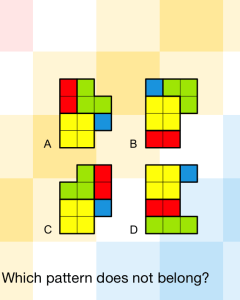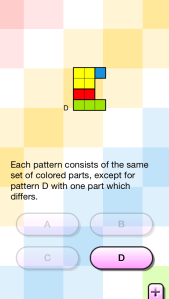I realized after searching through my puzzle collection that I possess many of them, but have completed very few. This is true of physical puzzles as well as puzzles on paper. My reasoning: actually doing a puzzle scares the heck out of me because I might not be able to do it. Ironically, I tell people I like puzzles because what crazy person would have a closet full of puzzles in her classroom if she didn’t love them? Fortunately, I make no claims to sanity on this blog, but I’d like to get better at actually attempting puzzles.
I came across an app called Puzzlium. This app highlights a little bit of all of their great puzzle apps, but the one that caught my eye was Puzzle Quizzes. I was drawn to the short format of these puzzle. It seemed like a good place to start anyway. Here’s an example:
Now, if you’re looking for a place to start in having students “make viable arguments,” this isn’t necessarily an obvious choice. But the simplicity of the question coupled with the inviting color scheme lay down a framework that allows all of them to enter the conversation. I had students who haven’t raised their hand all trimester actively engage in sharing their answers, summarize others, and thoughtfully comment on the arguments of their peers.
This task evolved as the day went on, and my question to my 5th hour class was:
Come up with as many reasons as you can for each of the patterns being the one that does not belong.
Tons of great responses using everything from which colors touched one another to number of blocks in each row/column to perimeter of the total figure. I’ll bet each student in my 5th hour came up with a different argument.
The question that, of course, I wasn’t able to avoid was “So what’s the right answer?” I turned that one right back on them.
“what do you THINK the right answer is? Was there one or more arguments that stood out as “better” than the rest?” The overwhelming response was No. The arguments given were solid and the instructions were ambiguous.
Still, they must know the “right” answer. I made sure to praise their efforts on constructing and presenting their arguments. However, here is the “back of the book” answer:
Showing them this seemed to invite the usual, “ha, I was right and you were wrong” mentality. Maybe next time I’ll resist their pleas and stick with all of them believing they were right.


I like your idea of having them come up with as many possible, viable answers to exclude a pattern. I found myself challenged to do just that and I could come up with at least one descriptor to eliminate one of the answers. The many answers scenario challenges perception.
Agreed: there isn’t a “right” answer. On this one it could be C because that’s the only one where the squares on the left don’t form a wall of four squares.
It would be nice to do this puzzle where there all four could be “answers” and give them out to different groups of kids, or even different classes, and see who could best refute the argument. If that was the case, then the only wrong answer would be settling for a “right” answer without at least providing some analysis of the other viewpoint.
It’s remarkable iin suppoirt off me too have a web page, which is good
for my experience. thanks admin
Hi there! I could have sworn I’ve been to this site before but after checking through some
of the post I realized it’s new to me. Nonetheless, I’m definitely
delighted I found it and I’ll be bookmarking and checking back often!